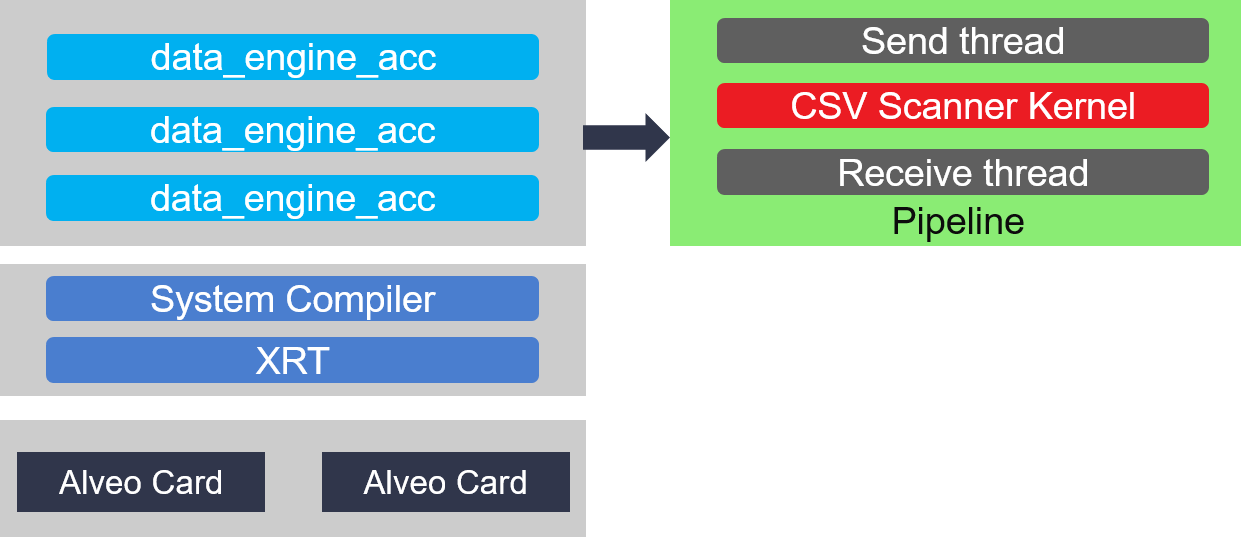Vitis Data Analytics Library Tutorial¶
Data Analytics and Hardware Acceleration¶
Data analytics aims to accelerate variety application including data mining, text processing, formatting from raw data to dataframe and querying operations on spatial data.
As an typical use case of data analysis, CSV Scanner is used to convert csv data into formatted data storage for subsequent analysis. Xilinx Alveo card can help improve CSV Scanner’s performance in following way:
- Instruction parallelism by creating a customized and long pipeline.
- Data parallelism by processing multiple rows/files at the same time.
- Customizable memory hierarchy of BRAM/URAM/DDR, providing high bandwidth of memory access to help operators.
How Vitis Data Analytics Library Works¶
Vitis data analytics library targets to help data analysis developers to accelerate analysis execution. It provides three layers of APIs, namely L1 / L2 / L3. Each tackles different parts of the whole processing.
- L3 provide pure software APIs for:
- Define data structures to describe input / output / operation types and parameters.
- Provide combination of operations for acceleration. These combinations are commonly used and easy to fit into the whole execution plan (decompress + parser + filter + format output).
- Schedule jobs, distributing sub jobs among all FPGA cards, pipeline data transfers and kernel executions.
- L2 APIs are kernels running on FPGA cards. Each time called, they will finish certain processing according to input configs. L2 APIs are combinations of multiple processing unit, each units consists of multiple processing stage. In this way, kernels could both processing multiple data at the same time and apply multiple operations to the same data. L2 API design subject to resource constraints and will differs according to FPGA cards.
- L1 APIs are basic operators in processing, like csv parser. They’re all highly optimize HLS design, providing optimal performance. They’re all template design, make them easier to scale and fit into different resource constraint.
L3 API – CSV Scanner Engine¶
Target Audience and Major Features¶
Target audience of L3 API are users who just want to link a shared library and call the API to accelerate part of execution plan on FPGA cards.
The major feature of L3 API are:
- Generalized execution. L3 API pre-defined operator combinations like gunzip_csv, its flow is “decompress + csv parser + filter + format output”. More generalized execution will be provided in the future.
- Automatic card management. As soon as program created a instance, it will scan the machine and find all qualified Xilinx FPGA cards by their shell name. It will load the cards with the xclbins, management buffers and schedule tasks.
- Parallel Accelerate. Reasonably schedule Send Thread, Kernel Run and Receive Thread, and improve End-to-End performance.

Command to Run L3 cases¶
cd L3/tests/vitis_case_folder # build and run one of the following using u200 platform make run TARGET=sw_emu DEVICE=/path/to/xilinx_u200_gen3x16_xdma_2_202110_1.xpfm # delete generated files make cleanall
Here, TARGET decides the FPGA binary type
sw_emuis for software emulationhw_emuis for hardware emulationhwis for deployment on physical card. (Compilation to hardware binary often takes hours.)
Besides run, the Vitis case makefile also allows host and xclbin as build target.
L2 API – CSV Scanner kernels¶
Target Audience and Major Features¶
Target audience of L2 API are users who has certain understanding of HLS and programming on FPGA and want to make modification on kernels, including:
- Operator combinations in kernel, like number of operators or operator pipeline. Most L1 APIs and glue logics inside L2 kernels are connect with streams. Users could add more operators into kernels to increase its performance as long as it is not bounded by other factors like logic resource and memory bandwidth.
- Add more pre-processing and post-processing to kernel, like compression / decompression. Certain files might store its data in compressed format to save the memory space and bandwidth to transfer. Adding decompression module to build longer processing pipeline will save the time to decompress the data and increase system performance.
- Test correctness in sw-emu, hw-emu and on-board.
- Get accurate kernel resources and clock.
- Analyze kernel’s timing performance and throughput.
Command to Run L2 cases¶
cd L2/tests/vitis_case_folder # build and run one of the following using u200 platform make run TARGET=sw_emu DEVICE=/path/to/xilinx_u200_gen3x16_xdma_2_202110_1.xpfm # delete generated files make cleanall
Here, TARGET decides the FPGA binary type
sw_emuis for software emulationhw_emuis for hardware emulationhwis for deployment on physical card. (Compilation to hardware binary often takes hours.)
Besides run, the Vitis case makefile also allows host and xclbin as build target.
L1 API¶
Target Audience and Major Features¶
Target audience of L1 API are users who is familiar with HLS programming and want to tests / profile / modify operators or add new operator. With the HLS test project provided in L1 layer, user could get:
- Function correctness tests, both in c-simulation and co-simulation
- Performance profiling from HLS synthesis report and co-simulation
- Resource and timing from Vivado synthesis.
Command to Run L1 cases¶
cd L1/tests/hls_case_folder make run CSIM=1 CSYNTH=0 COSIM=0 VIVADO_SYN=0 VIVADO_IMPL=0 \ DEVICE=/path/to/xilinx_u200_gen3x16_xdma_2_202110_1.xpfm
Test control variables are:
CSIMfor high level simulation.CSYNTHfor high level synthesis to RTL.COSIMfor co-simulation between software test bench and generated RTL.VIVADO_SYNfor synthesis by Vivado.VIVADO_IMPLfor implementation by Vivado.
For all these variables, setting to 1 indicates execution while 0 for skipping.
The default value of all these control variables are 0, so they can be omitted from command line
if the corresponding step is not wanted.